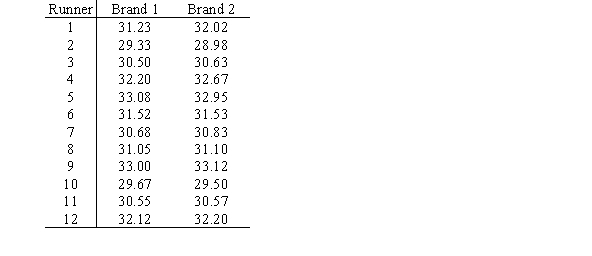Multiple Choice
Twelve runners are asked to run a 10-kilometer race on each of two consecutive weeks.In one of the races,the runners wear one brand of shoe and in the other,a different brand.The brand of shoe they wear in each race is determined at random.All runners are timed and are asked to run their best in each race.The results (in minutes) are given below.  Use the sign test for matched pairs to determine if there is evidence that times using Brand 1 tend to be faster than times using Brand 2.Determine which of the following statements is TRUE.
Use the sign test for matched pairs to determine if there is evidence that times using Brand 1 tend to be faster than times using Brand 2.Determine which of the following statements is TRUE.
A) We would not reject the null hypothesis of no difference at the 0.10 level.
B) We would reject the null hypothesis of no difference at the 0.10 level but not at the 0.05 level.
C) We would reject the null hypothesis of no difference at the 0.05 level but not at the 0.01 level.
D) We would reject the null hypothesis of no difference at the 0.01 level.
Correct Answer:

Verified
Correct Answer:
Verified
Q2: Let n<sub>1</sub> represent the sample size of
Q3: A simple random sample should be used
Q4: The heights (in inches)of men in the
Q5: A study was done to determine if
Q6: Large sample sizes are needed to find
Q7: When the underlying assumptions for the use
Q8: Two-sample t procedures are more robust than
Q9: The pooled two-sample t procedure is based
Q10: When calculating a one-sample t confidence interval,which
Q11: A test of significance is to be